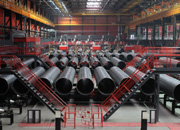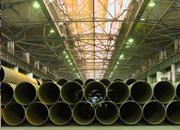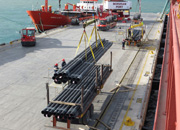Carbon steel pipe is a common material with a wide range of uses in the steel industry, and its diameter standards are crucial for engineering design and use. Carbon steel pipe diameter standards refer to the specified range of pipe diameters, typically expressed in nominal diameter (DN) or inches. These standards are crucial for pipe selection, design, and installation, as pipes of different diameters vary in load-carrying capacity, fluid transport capacity, and installation methods.
Understanding the importance of carbon steel pipe diameter standards requires further exploration from the following perspectives:
1. The Significance of Standards: Standardized specifications for carbon steel pipe diameters ensure consistent dimensional and performance requirements during pipe design, manufacturing, installation, and use. This facilitates coordination and consistency among project designers, manufacturers, and contractors, and helps ensure project quality and safety.
2. Classification of Carbon Steel Pipe Diameter Standards: Carbon steel pipe diameter standards vary depending on the standards-setting bodies in different countries and regions. Common standards include International Standards (ISO), American Standards (ASTM), and European Standards (EN). These standards typically specify parameters such as the nominal diameter range, nominal wall thickness, and nominal weight of pipes, as well as requirements for tolerances and surface quality.
3. The Impact of Carbon Steel Pipe Diameter Standards: Carbon steel pipes of different diameters are suitable for different project needs. Selecting the appropriate pipe diameter can effectively reduce costs, improve efficiency, and ensure the safe and stable operation of the piping system. In engineering design, it is necessary to comprehensively consider factors such as fluid transport capacity, pipe load capacity, and system pressure to select a pipe diameter that meets the standards.
4. Application of Carbon Steel Pipe Diameter Standards: In actual projects, it is crucial to select the appropriate diameter of carbon steel pipe based on specific application requirements and standards. Consider not only the pipe's inner diameter, but also factors such as pipe wall thickness, pipe material, and connection method to ensure the stability and safety of the piping system.
In summary, understanding carbon steel pipe diameter standards is crucial for engineering design and use. Only by thoroughly understanding the requirements of various standards and specifications and strictly implementing them in practice can the safe and reliable operation of carbon steel piping systems be guaranteed.
 Threeway Steel is known as a professional supplier engaged in manufacturing and distributing a wide range of steel pipe, and our headquarter located the central part of China – Hunan and six associated factories throughout China.
Threeway Steel is known as a professional supplier engaged in manufacturing and distributing a wide range of steel pipe, and our headquarter located the central part of China – Hunan and six associated factories throughout China.
 Threeway Steel is known as a professional supplier engaged in designing, manufacturing and distribution of a wide range of steel products with the headquarter located the central part of China – Hunan and six associated factories throughout China.
Threeway Steel is known as a professional supplier engaged in designing, manufacturing and distribution of a wide range of steel products with the headquarter located the central part of China – Hunan and six associated factories throughout China.
 Threeway Steel is known as a professional supplier engaged in designing, manufacturing and distribution of a wide range of steel products with the headquarter located the central part of China – Hunan and six associated factories throughout China.
Threeway Steel is known as a professional supplier engaged in designing, manufacturing and distribution of a wide range of steel products with the headquarter located the central part of China – Hunan and six associated factories throughout China.
 Threeway Steel is known as a professional supplier engaged in designing, manufacturing and distribution of a wide range of steel products with the headquarter located the central part of China – Hunan and six associated factories throughout China.
Threeway Steel is known as a professional supplier engaged in designing, manufacturing and distribution of a wide range of steel products with the headquarter located the central part of China – Hunan and six associated factories throughout China.
 Threeway Steel is known as a professional supplier engaged in designing, manufacturing and distribution of a wide range of steel products with the headquarter located the central part of China – Hunan and six associated factories throughout China.
Threeway Steel is known as a professional supplier engaged in designing, manufacturing and distribution of a wide range of steel products with the headquarter located the central part of China – Hunan and six associated factories throughout China.

